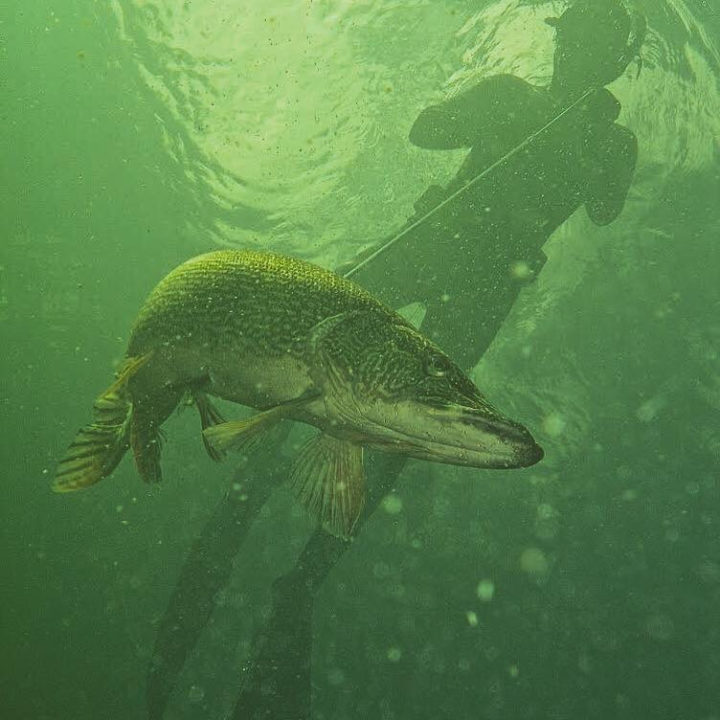The Local newsletter is your free, daily guide to life in Colorado. For locals, by locals. Sign up today!
My brother takes fishing seriously. So, it wasn’t a total surprise to be snorkeling at sunrise in wetsuits and diving fins at Chuck Lewis State Wildlife Area in Steamboat Springs a few years back. We alternately swam and bobbed beneath the surface of the pond looking for pike. It might sound odd, especially in Colorado where most anglers throw flies on the water, but we were spearfishing, an ancient sport in which you stalk and spear a fish underwater.
Spearfishing’s roots are old (think Poseidon’s trident), but the sport has evolved with specialized equipment that allows anglers to dive beneath the surface and precisely strike fish with spearguns. It’s done in fresh or saltwater, but perhaps better known in sparkling blue oceans with big catch like tuna and snapper.
True, Colorado is an offbeat place to spearfish. Our water is often cold and murky, so the endeavor involves less tropical glamour and more outdoor ruggedness. Nevertheless, the Rockies are home to a small and devoted group of enthusiasts. Aside from my brother, one of those enthusiasts is Ryan Koeneke, a 31-year old Parker resident who began spearfishing two years ago. He estimates there may be as many as 150 spearfishers in the state, with 50 of them active (Colorado Parks and Wildlife does not track specific numbers of spearfishers, says Jeff Spohn, the northeast region senior aquatic biologist there).
Though it’s unclear how many spearfishers there are in Colorado, one thing is certain: There’s room for more. So, if you want to become one of these underwater anglers, here’s what you need to know to get started.
What You Need To Know
Spearfishing combines the sports of fishing and hunting, says Koeneke, who often spearfishes off the shoreline of Pueblo Reservoir south of Colorado Springs. He wears a camouflage wetsuit, snorkel, mask, and fins—diving under the water and using a speargun to strike fish. The speargun trigger releases strong elastic bands to propel the spear forward and dispatch the fish.
You eat what you catch in spearfishing, which is one of the philosophies that drew Koeneke to the sport. In Colorado, you can spearfish for northern pike and carp, invasive species that often take over the habitat of more desirable native species like trout. At Green Mountain Reservoir outside of Silverthorne, spearfishers, along with other anglers, can receive a $20 bounty for each northern pike they turn into CPW in an effort to knock down the population of this predatory fish. East of the Continental Divide you can take gizzard shad and white or longnose suckers. Pueblo Reservoir is unique in allowing spearfishing for catfish and hybrid striped bass, tasty fish that Koeneke panfries for Baja-style tacos.

Spearfishing involves freediving, sometimes 20 to 40 feet down in reservoirs, says Brandon Miller, president of the Rocky Mountain Spearfishing Association. Koeneke, who is also a member of the association, took a course to learn how to maximize his breath holding during freediving. The longer you can hold your breath, the longer you can spend underwater stalking and spearing a fish. “It’s a Zen-like extreme sport which is the weird dichotomy of it,” he says.
Always spearfish with a buddy, says Miller, who tries to fish with one or two other anglers. They take turns diving down, recovering at the surface, and checking for signs of shallow water blackout (a serious, sometimes fatal condition when free divers lose consciousness). “Safety is our number one goal,” Miller says. Rocky Mountain Spearfishing, which has 112 members, hosts an online freshwater tournament starting in May and freshwater nationals at Lake Mead in Nevada in June.
Spohn says you should be familiar with the spearfishing regulations in Colorado, which you can find online. Just like all anglers, review the regulations for each water body and the equipment that’s legal there, he says. “They should be aware of their surroundings for other anglers and recreationalists,” he adds.
My own experience spearfishing didn’t yield any pike that morning in Steamboat Springs, probably because I was more tentative than Zen-like in my approach. But the excuse to try to an entirely new sport with my brother in the Colorado outdoors will always get me out of bed at dawn.
What Equipment You’ll Need
Spearfishing gear is part hunting, part fishing, and part free-diving, so it can be tough to find a brick-and-mortar retailer on the Front Range where you can find all the right equipment. You’ll need to buy most of your gear online; here are the basics:
Wetsuit: A 3.5-5mm wetsuit will keep you warm in the spring, but not too hot in the summer. A camouflage wetsuit shows you’re serious (to the fish and your buddies). Neoprene gloves are a bonus.
Snorkel and diving mask: A typical J-snorkel works fine, but dry and semi-dry versions won’t allow water back down the breathing tube. Diving masks for spearfishing are unique, sitting closer to the face with a black silicone skirt to block out light underwater in low visibility, says Miller.
Fins: Longer, free-diving fins can help you dive deeper and more efficiently.
Speargun: In Colorado, you’ll need a shorter gun that’s maneuverable when visibility is low. A good length is 70 cm, and many can be found in the $100 range, Miller says. “I always tell people to start out simple,” he says. It’s also wise to wear a dive knife on a belt or your ankle, too.
Diver-down flag: Regulations require that you’re always within 100 feet of a float with the National Divers’ symbol. You can buy an inflatable version or display the flag on your boat or the shoreline.








